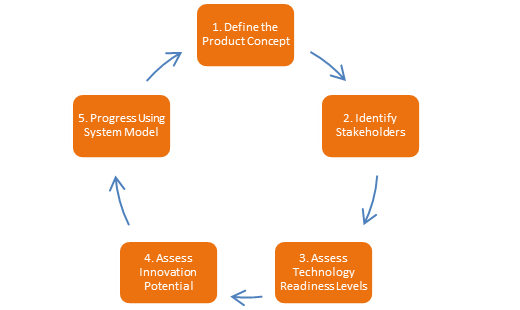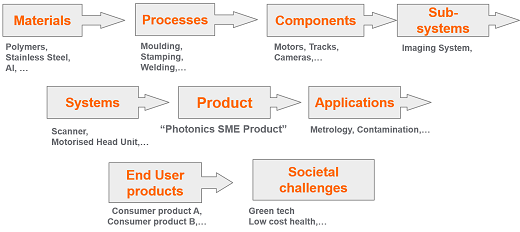Dr Ian Mc Cabe from the National University of Ireland, Galway, describes a value chain analysis technique developed as part of a Horizon2020-funded project, RespiceSME
What makes a good idea? People and organisations throughout the photonics industry struggle with this problem daily. There is no conclusive way to answer this question; however, there are a few fundamentals that must be in place for an idea to be both innovative and commercial.
RespiceSME is a coordinated action project aiming to increase the penetration of photonics into industry in Europe. We have developed a technique for analysing company specific value chains that will help identify and develop the highest potential product concepts targeting new markets or sectors. By strengthening individual photonics companies, the sector as a whole and its penetration into other fields is also strengthened.

The five steps for value chain analysis (Credit: Dr Gerard O Connor and Dr Ian Mc Cabe, NCLA, National University of Ireland)
The method involves recognising key factors that are crucial for success at a very early stage while lining up the elements essential for growth. Numerical values are assigned to important properties, and scores are compiled to indicate where a company should consider targeting their efforts.
This technique is designed for small companies and researchers who may not have the resources available to develop multiple opportunities for their good idea. Although the process takes a bit of time to complete, it will provide the user with a comprehensive understanding not only of what they are trying to commercialise, but the sectors they are trying to break into.
The analysis involves five basic stages: 1 – Identify the product: 2 – Identify the stakeholders; 3 – Assess technology readiness levels; 4 – Assess the innovation potential; and 5 – Develop the system model (see figure one).
Step 1: Identify the product
The product referred to here can take several forms. Depending on the nature of the company or individual, it may be an idea, an expertise, a service, or a physical device. The key at this stage is to get a very deep understanding of what the product is: how it fits within the identity of the company, how it fits within the expertise of the proposers, and how the product fits into the market. We use system modelling and a Technical Value Chain (the chain of value creation from materials to the product and on to a societal challenge) to extract how and why the product is significant, and identify the applications, end users, and societal challenges that might relate to it. We also take this opportunity to really analyse the product in terms of technology readiness level (TRL), innovation potential, and where it lies on the ‘S-curve’ of technology uptake.

The Technical Value Chain follows a predefined format.
Step 2: Stakeholder analysis
Once the product has been thoroughly dissected and understood, we begin the process of identifying who might use it. This is done by following the Technical Value Chain as defined in step 1. Specifically, we focus on the downstream/buyer side of the value chain. We use the terms associated with the applications, end users, and the societal challenges to form the basis of a keyword ‘tree’ that will have the product at its heart. These keywords are coupled to custom search engines that will target potential customers based on a specific industry, region, market, or sector that is of interest. Custom search engines allow stakeholders to be identified, prioritising those with the most desirable traits for the user. Stakeholders are validated by the generation of a simple value proposition for each one. Once a stakeholder has been captured, a series of questions are asked about them to assess some basic qualities which contribute to a ‘stakeholder relevance score’.
Step 3: Assess technology readiness levels
Technology readiness levels (TRLs) are estimated based on the value proposition proposed in step 2. TRLs are useful here to show which stakeholders would be taking a risk by using your product. The TRL is estimated based on whatever information can be gleaned about the company from web-based or industry sources. The value chain analysis gives highest priority to stakeholders that would use the product at a mid to upper range TRL as they represent the best balance between risk and potential growth. Those with a low TRL are given the lowest priority.
Step 4: Asses the innovation potential
The innovation potential in this context indicates the potential of the product to be successful/ innovative in its sector. NUIGalway has developed an innovation potential index that scores several key measures on the ‘market’ and the ‘technical’ application of the product. These indicators have been identified from a broad range of economic theories that all support scalable growth and appropriate timing.
The innovation potential index is applied here to the value proposition for each stakeholder to give a broad indication of how likely they would be to benefit from using the product. Innovation potential is also scored numerically and contributes to an overall stakeholder scoring.
The stakeholder score is compiled for all the stakeholders identified for each application, end user, and societal challenge from step 2. This gives an aggregate score for the product application that can help guide the path of development.
Step 5: Develop the system model
The system model as referenced in step 1 is a ‘blueprint’ that shows all the elements necessary for scalable growth. This ‘blueprint’ is used in this final stage as a framework within which the top ranked stakeholders can be placed. The result of this is a model for the entire system around the product that is based on the inputs of the user and the applications of the product. Gaps in the system model represent areas where the user is missing key stakeholders.
The comprehensiveness of the system model can be a powerful indicator for a product that is targeted in the right space and primed for solid growth.
Iterative process
The result from the first round of Value Chain Analysis will give the user a broad overview of the potential for the product in a number of diverse applications. The stakeholder scores and the regional/sector based searches allow a course grained picture of the products potential to be determined. For a finer comparison between potential applications the analysis can be performed again, focusing in on the highest potential application and the subsequent end users and societal challenges. In fact, the entire process can be repeated on an ongoing basis to give continued guidance for product direction.
Once a product direction has been settled on by the user the process can be applied to the upstream / supplier side of the value chain to give a panoramic snapshot of what the highest potential version of the new product would look like.
The Value Chain Analysis technique has been developed by industry research fellow Dr Gerard O Connor and Dr Ian Mc Cabe of the National Centre for Laser Application (NCLA) located in National University of Ireland, Galway. The work was completed thanks to support for RespiceSME through Horizon2020 and the European Commission.
Further information can be found at www.respice-sme.eu/ or through email to: ian.mccabe@nuigalway.ie


